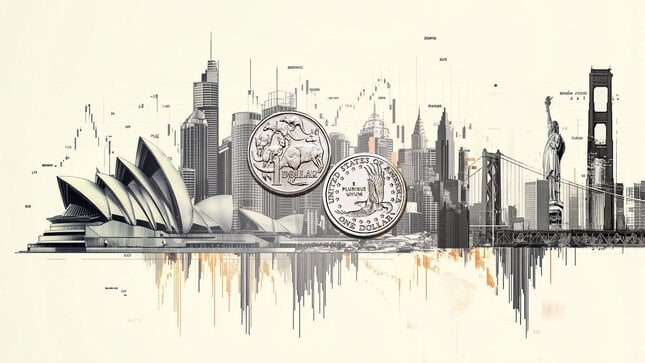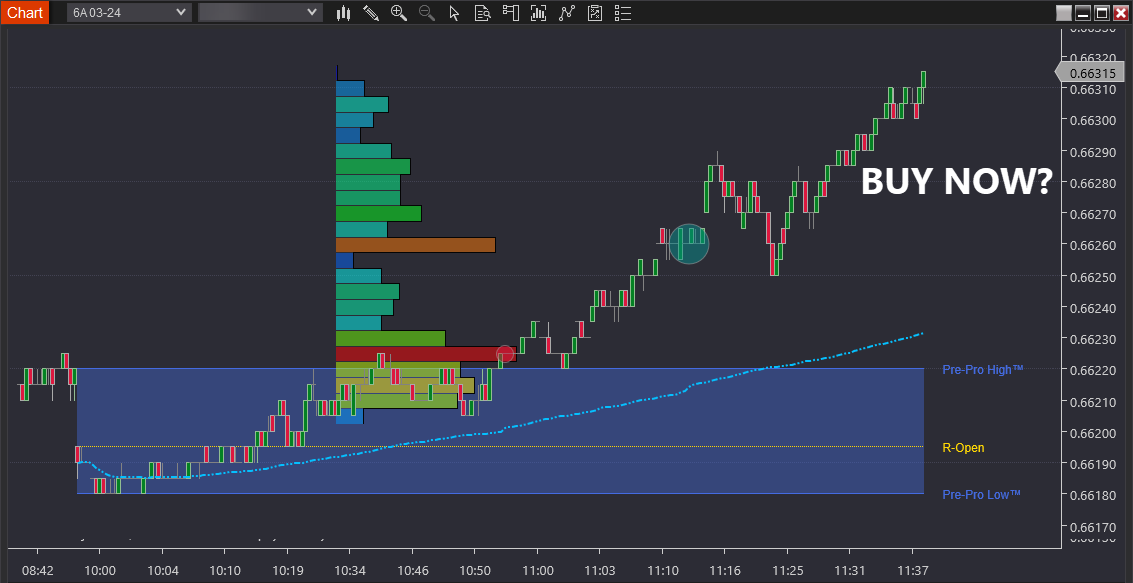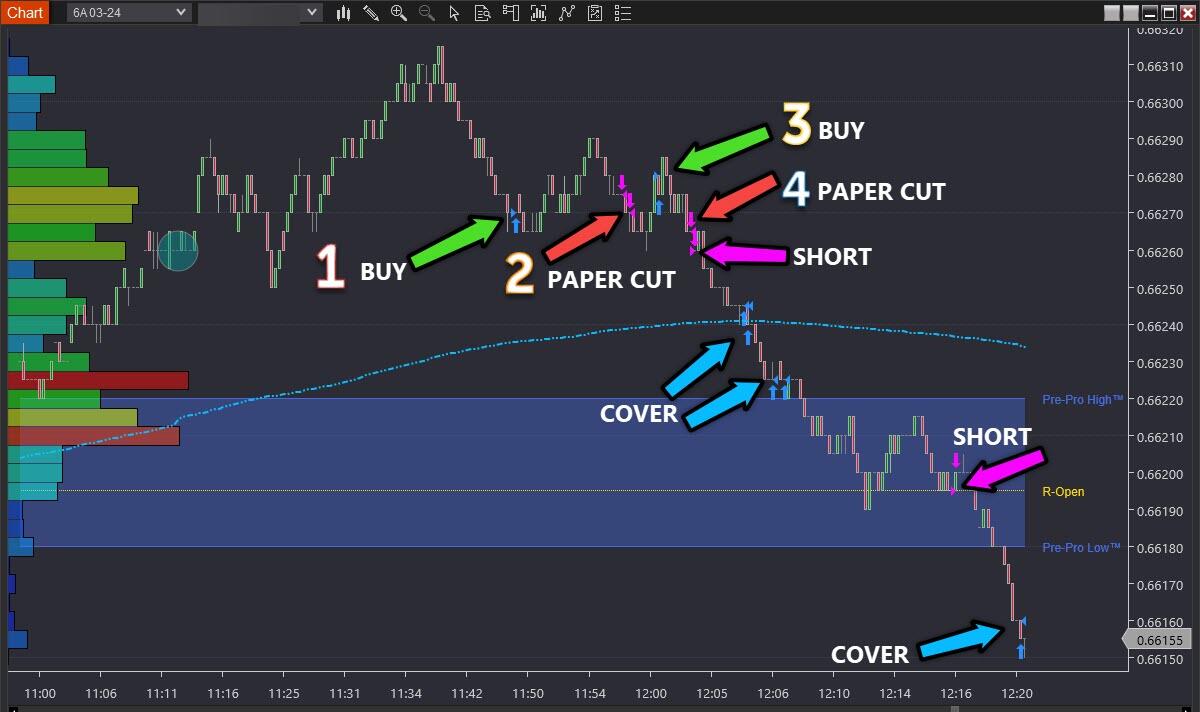Here's a question for you...
Last Friday's game plan unearthed a significant opportunity to trade the long side (buy to sell higher!).
(Like envisioning a completed jigsaw puzzle—your game plan is your roadmap for confidently navigating the day's price moves.)
Looking at the chart below:
Do you buy it right now? If yes:
- How much do you buy?
- Where's your stop?
- Where can you move it for a risk-free trade?
- Do you take partial profits?
- Or do you look to add to the trade?
- When and where?
Or do you wait for a price pullback before entering? And if so:
- How far does it need to do that?
- But what if it doesn't?
- And what about your stop?
- How far away do you place it?
- Does the distance of your stop vary depending on where your entry is?
We haven't even scratched the surface
But let's pause...
What if you didn't need to think about the answer?
Phew! Right?
Tell me:
Have you ever seen a learner driver navigating peak-hour traffic for the first time?
You feel for the driver knowing they're grappling with all the steps they need to take. It's a bit like the list of trade decisions above. Agree?
It sharply contrasts your experience of changing lanes to complete a right-hand turn.
Parallel parking, u-turns, stopping at red lights, navigating roundabouts—so many different scenarios you navigate with ease and barely a conscious thought. Correct?
What if entering and managing live trades was equally as straightforward? Well, guess what? This is exactly what playbook trades achieve.
(Playbook trades are the pieces to your completed jigsaw. Based on how the market behaves—they guide you to which strategy best fits your game plan.)
Playbook trades take the overwhelming experience of the list of trade decisions above and turn them into near-automatic responses like those you make while driving. Make sense?
And in all the driving scenarios what's the first consideration always? Safety. Correct?
Playbook trades are no different.
Now let me show you:
Moving forward from the chart above you see how the market unfolded in the chart below.
-
Can you see where the first buy was made at number 1?
-
And can you see where the safety trigger was activated by selling at number 2?
-
And see the 2nd buy at number 3?
-
Can you see where that was exited at number 4?
Question:
What do you notice about the safety exits? They're the equivalent of paper cuts. Correct?
Guess what?
When you know you're wrong with such a tiny move against you? You can trade much larger sizes without increasing your risk.
And why do that?
While delving into this topic warrants its own discussion... Essentially you're not relying on the market making less frequent large moves to receive a meaningful payout.
This overcomes a common trading challenge–the need for the market to hit a specific target—only to present an elusive opportunity before reversing. Sound familiar?
But a less apparent aspect of playbook trades is responsible for significant trading transformation—from grappling with constant negative performance to achieving consistency.
Do you have any guesses as to what it is?
Here's a clue...
Do you ever feel frightened you'll suddenly end up in a catastrophic collision with another vehicle as you pull up at a red light? It doesn't enter your mind. Correct?
But imagine you're travelling along the highway, and up ahead, you see the lights change. You know you should begin slowing down to give yourself ample time to bring your vehicle to a complete stop a the red light.
But as you take your foot off the accelerator and squeeze the break—you notice your car isn't slowing down.
Your brakes are failing, and you're about to run straight through the red light at a considerable speed into oncoming traffic. You're suddenly filled with legitimate fear for your safety.
Under normal circumstances, you don't experience fear while driving. Yet if faced with a dangerous scenario fear overwhelms you.
Now, if you're like most people who've been trading financial markets, you're bound to have experienced painful scenarios—experiences that you've gone through multiple times. Correct?
Understandably, your fear is ever-present. And it's detrimental because it inhibits your current trading. Agree?
But like stopping your car at a red light, playbook trades are a tool that removes the danger. Yet you don't instantly experience transformative change to fearless trading simply by knowing about playbook trades. Transformation occurs through action. Right?
Proficiency in driving isn't achieved immediately; it requires repetition. Similarly, it's common sense to trade in a simulated environment until you can successfully execute your playbook trades.
As a guide: When I work with a new client, you build repetitions in your first playbook trade at week 4. This is the same playbook trade underpins the bulk of my trading.
Just as stopping at a red light is an instinctive response, so does recognising the trading equivalent of running a red light.
You know this intimately—that feeling of apprehension when deviating from your playbook trades. And here's the beauty of it: that fear, though persistent, is your ally. It's a built-in safeguard, ensuring you avoid risky manoeuvres.
Your experience-based awareness of what's harmful keeps you from deviating from playbook trades. It's no different from why you don't second-guess stopping at a red light.
Playbook Trades transform your trading
Trading can involve an overwhelming number of decisions which easily leads to omissions and errors in your trading.
Playbook trades solve this problem by providing a clear roadmap, akin to effortlessly navigating familiar terrain. Just as you instinctively manoeuvre your car through well-known streets, playbook trades guide you confidently through the complexities of trading.
And like driving a car, all playbook trades focus on safety first, protecting your account capital.
Prior trading experience is often riddled with painful experiences that negatively impact future trading.
Consider a moment when you approach a traffic light: you stop at the red, not out of fear, but out of learned safety. Playbook trades offer this same assurance, removing the danger and instilling a sense of security in your trading decisions.
Moreover, many traders face the ongoing challenge of trades not reaching their targets, resulting in their trading accounts losing money because winning trades do not make up for the losses.
Playbook trades solve this without adding to the risk.
They amplify gains transforming a modest success into a lucrative opportunity.
If you're ready to transform your trading with playbook trades, reach out to someone with an extensive playbook who's experienced at transferring these skills.
Forex and derivatives trading is a highly competitive and often extremely fast-paced environment. It only rewards individuals who attain the required level of skill and expertise to compete. Past performance is not indicative of future results. There is a substantial risk of loss to unskilled and inexperienced players. The high degree of leverage can work against you as well as for you. Before deciding to trade any such leveraged products you should carefully consider your investment objectives, level of experience, and risk appetite. The possibility exists that you could sustain a loss of some or all of your initial investment and therefore you should not invest money that you cannot afford to lose. You should be aware of all the risks associated with trading on margin, and seek advice from an independent
Editors’ Picks

USD/JPY extends gains above 156.00 after the expected BoJ rate hike
USD/JPY sees a fresh leg higher and regains the 156.00 level in Friday's Asian trading. The Japanese Yen loses further ground, digesting the Bank of Japan's (BoJ) expected 25 bps rate hike to 0.75%. Traders now look to Governor Ueda's press conference for fresh directives.

AUD/USD remains sidelined above 0.6600 amid a steady US Dollar
AUD/USD steadies above 0.6600 in the Asian session on Friday, following the previous day's two-way price swings and a positive close. Against the backdrop of the RBA's hawkish stance, a positive risk tone is seen acting as a tailwind for the Aussie. The US Dollar looks to stabilize the softer US CPI-led slide, capping the pair's upside.

Gold declines despite Fed rate cut hopes as US inflation cools
Gold price keeps pushing lower below $4,350 in Asian trading hours on Friday. The precious metal stays in the red due to some profit-taking and weak long liquidation from shorter-term futures traders.

Bitcoin, Ethereum and Ripple correction slide as BoJ rate decision weighs on sentiment
Bitcoin, Ethereum, and Ripple are extending their correction phases after losing nearly 3%, 8%, and 10%, respectively, through Friday. The pullback phase is further strengthened as the upcoming Bank of Japan’s rate decision on Friday weighs on risk sentiment, with BTC breaking key support, ETH deepening weekly losses, and XRP sliding to multi-month lows.

Bank of England cuts rates in heavily divided decision
The Bank of England has cut rates to 3.75%, but the decision was more hawkish than expected, leaving market rates higher and sterling slightly stronger. It's a close call whether the Bank cuts again in February or March.
RECOMMENDED LESSONS
Making money in forex is easy if you know how the bankers trade!
I’m often mystified in my educational forex articles why so many traders struggle to make consistent money out of forex trading. The answer has more to do with what they don’t know than what they do know. After working in investment banks for 20 years many of which were as a Chief trader its second knowledge how to extract cash out of the market.
5 Forex News Events You Need To Know
In the fast moving world of currency markets where huge moves can seemingly come from nowhere, it is extremely important for new traders to learn about the various economic indicators and forex news events and releases that shape the markets. Indeed, quickly getting a handle on which data to look out for, what it means, and how to trade it can see new traders quickly become far more profitable and sets up the road to long term success.
Top 10 Chart Patterns Every Trader Should Know
Chart patterns are one of the most effective trading tools for a trader. They are pure price-action, and form on the basis of underlying buying and selling pressure. Chart patterns have a proven track-record, and traders use them to identify continuation or reversal signals, to open positions and identify price targets.
7 Ways to Avoid Forex Scams
The forex industry is recently seeing more and more scams. Here are 7 ways to avoid losing your money in such scams: Forex scams are becoming frequent. Michael Greenberg reports on luxurious expenses, including a submarine bought from the money taken from forex traders. Here’s another report of a forex fraud. So, how can we avoid falling in such forex scams?
What Are the 10 Fatal Mistakes Traders Make
Trading is exciting. Trading is hard. Trading is extremely hard. Some say that it takes more than 10,000 hours to master. Others believe that trading is the way to quick riches. They might be both wrong. What is important to know that no matter how experienced you are, mistakes will be part of the trading process.
The challenge: Timing the market and trader psychology
Successful trading often comes down to timing – entering and exiting trades at the right moments. Yet timing the market is notoriously difficult, largely because human psychology can derail even the best plans. Two powerful emotions in particular – fear and greed – tend to drive trading decisions off course.



